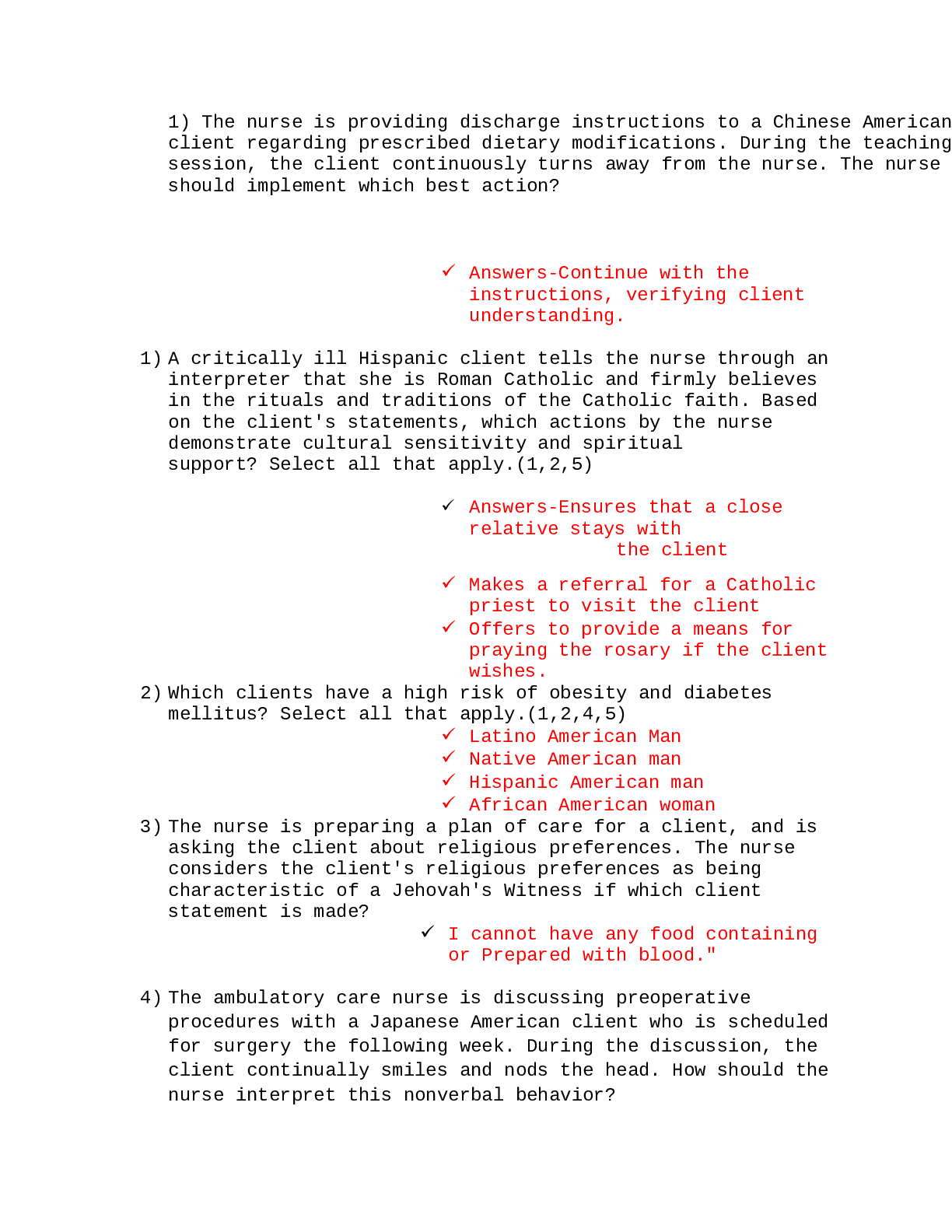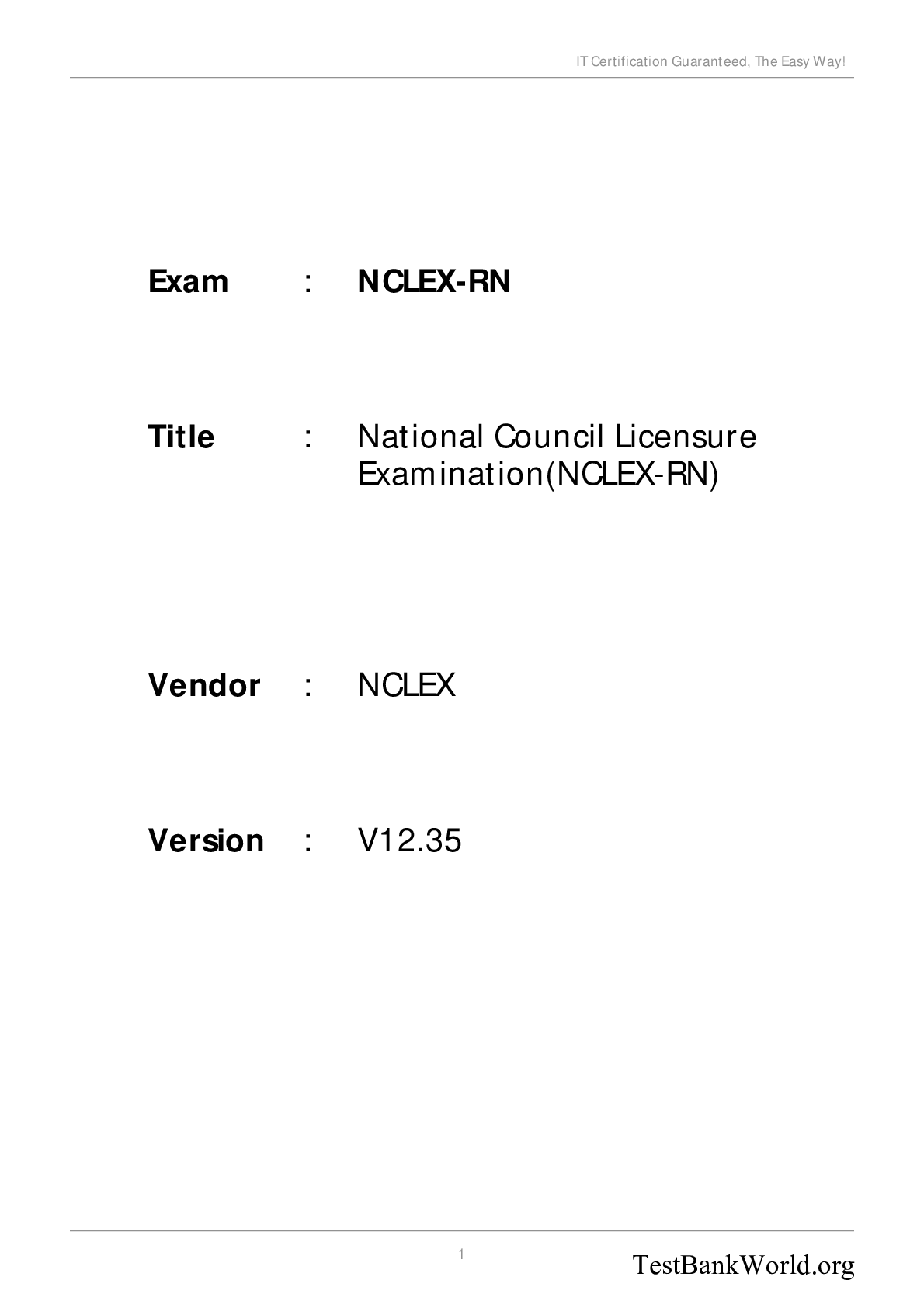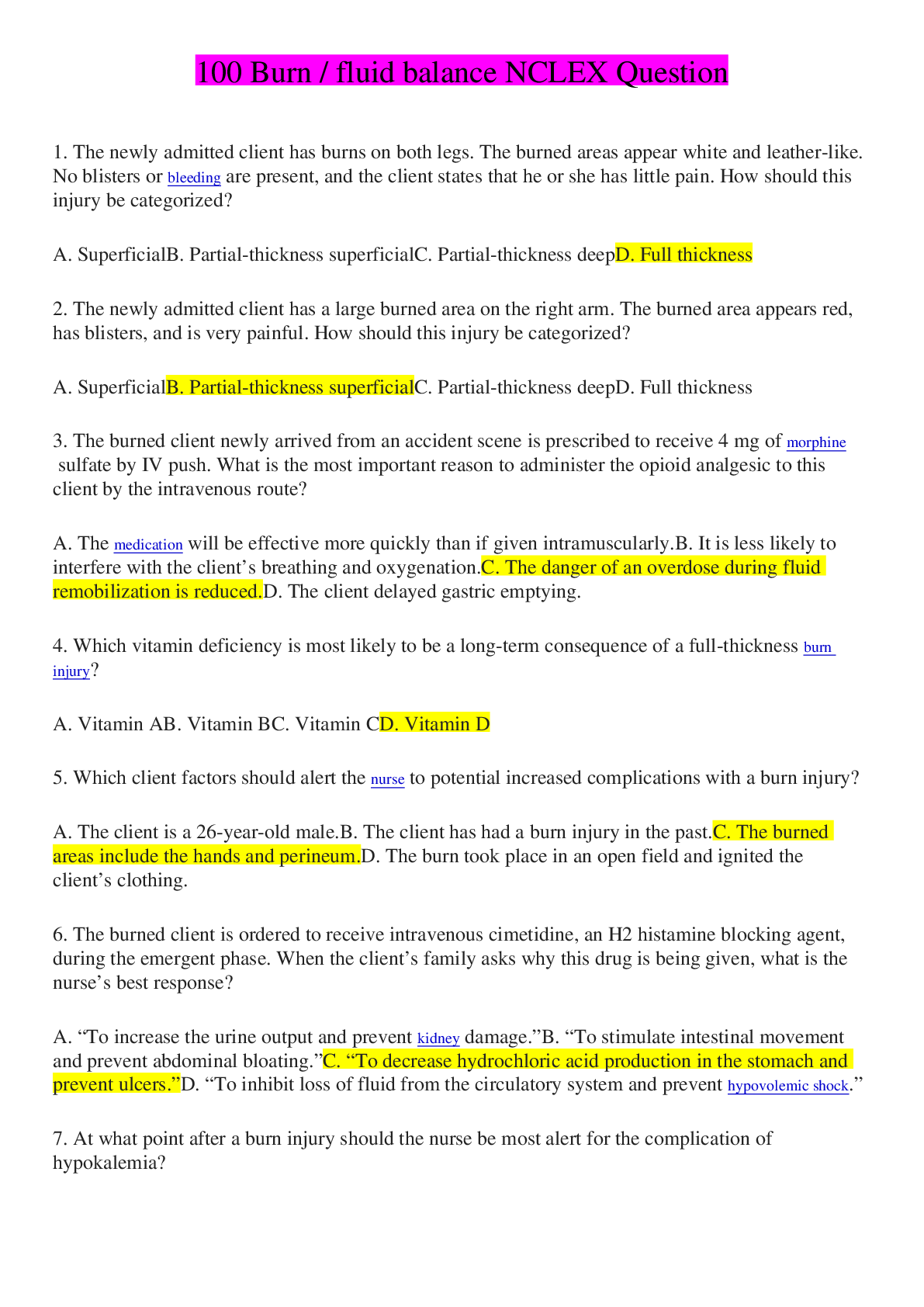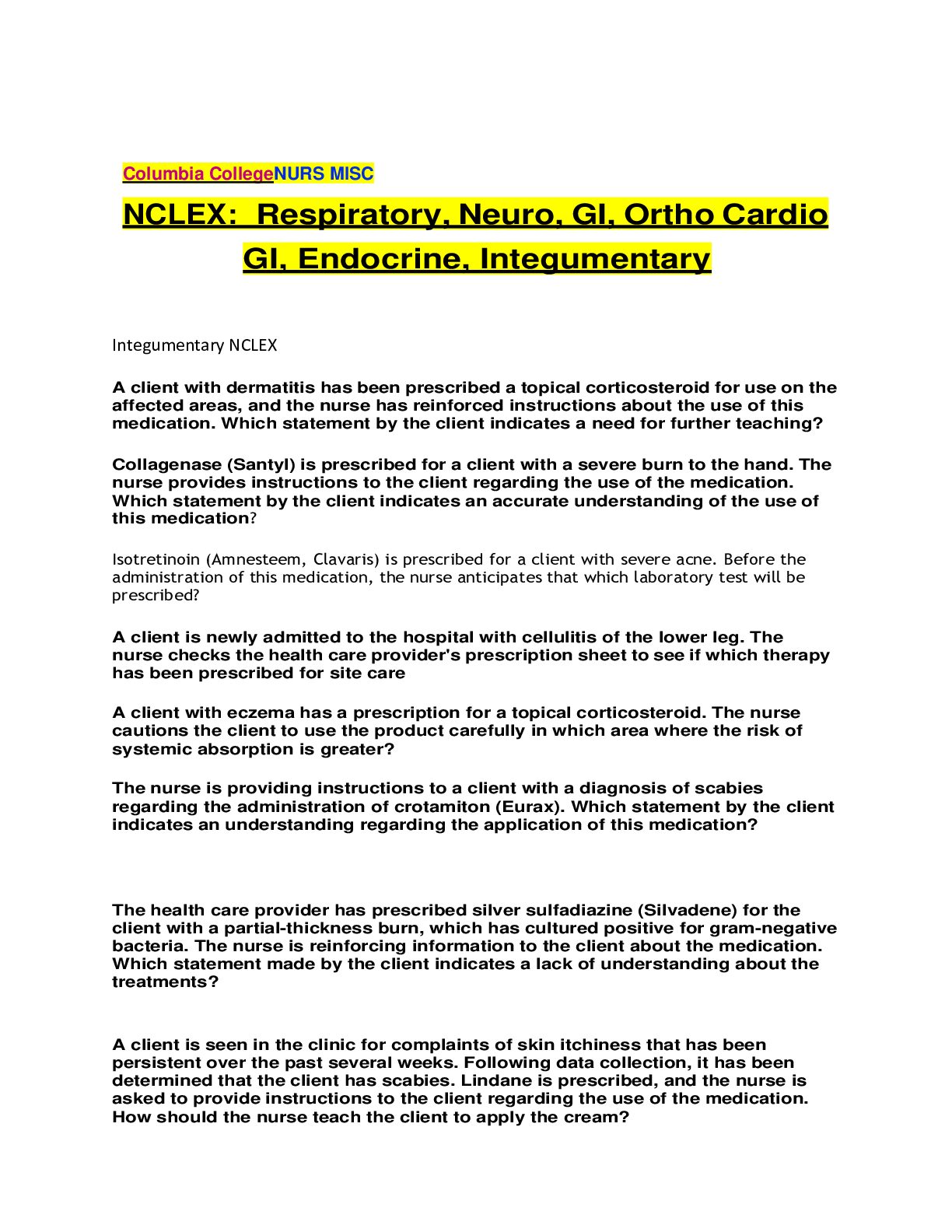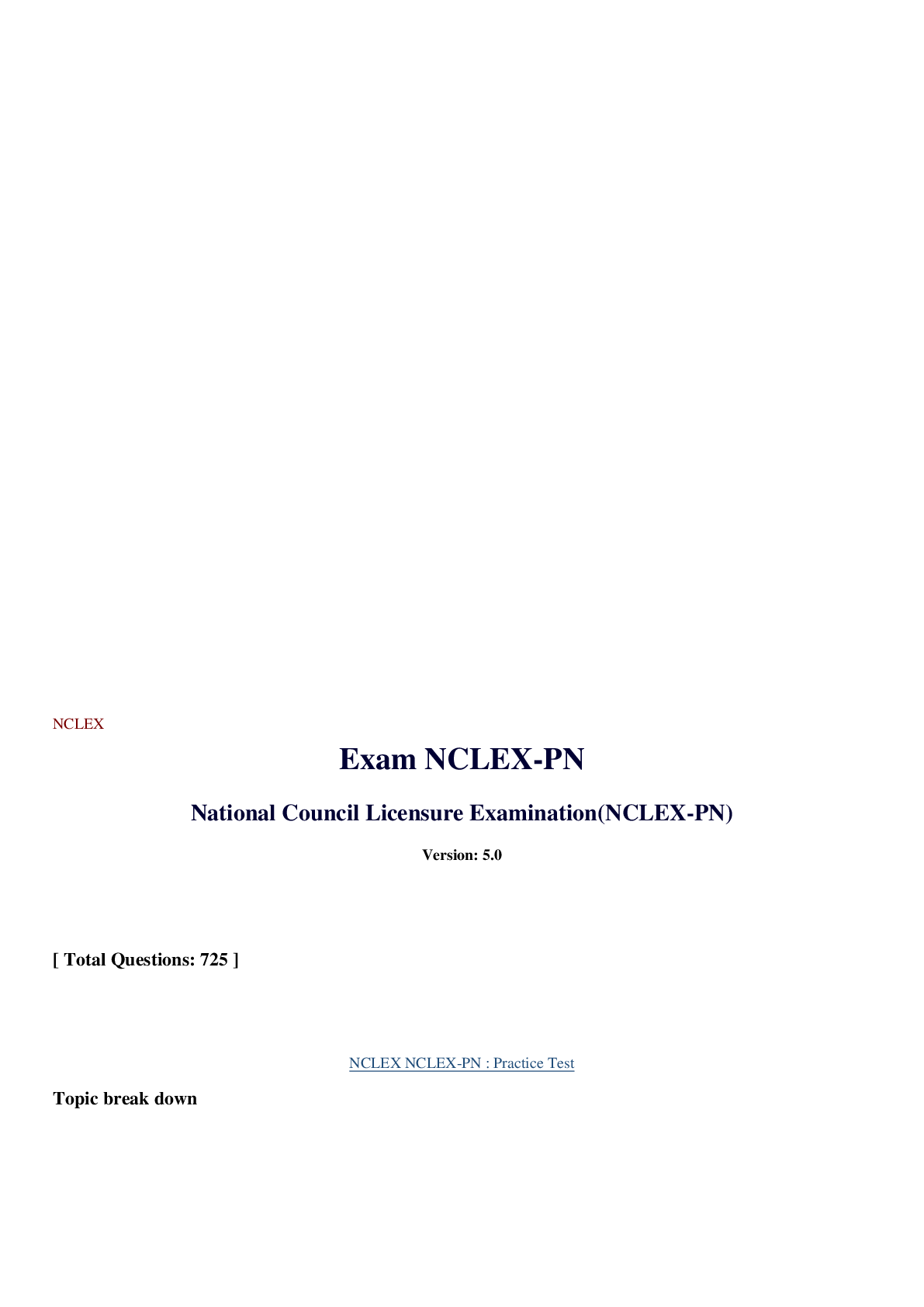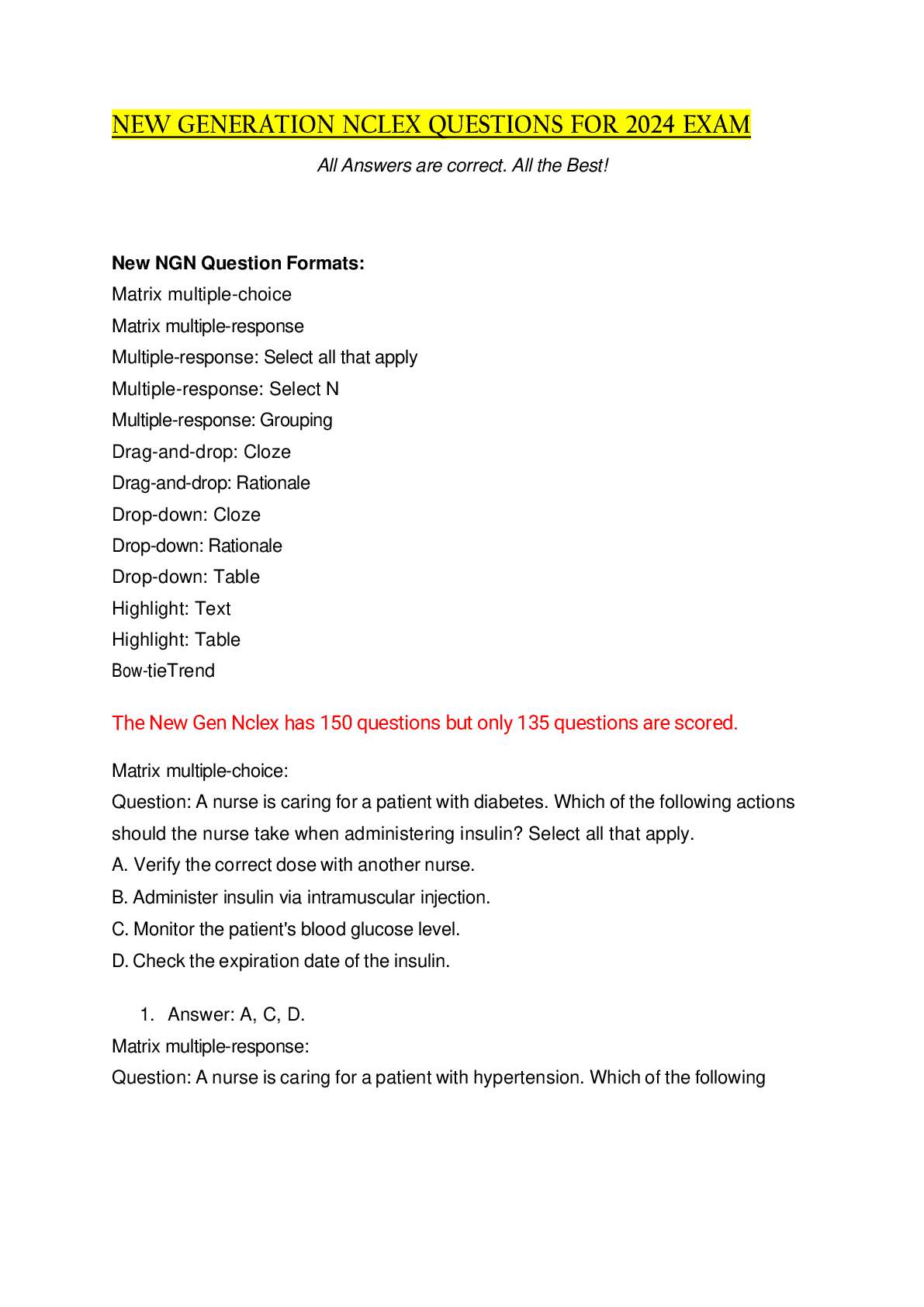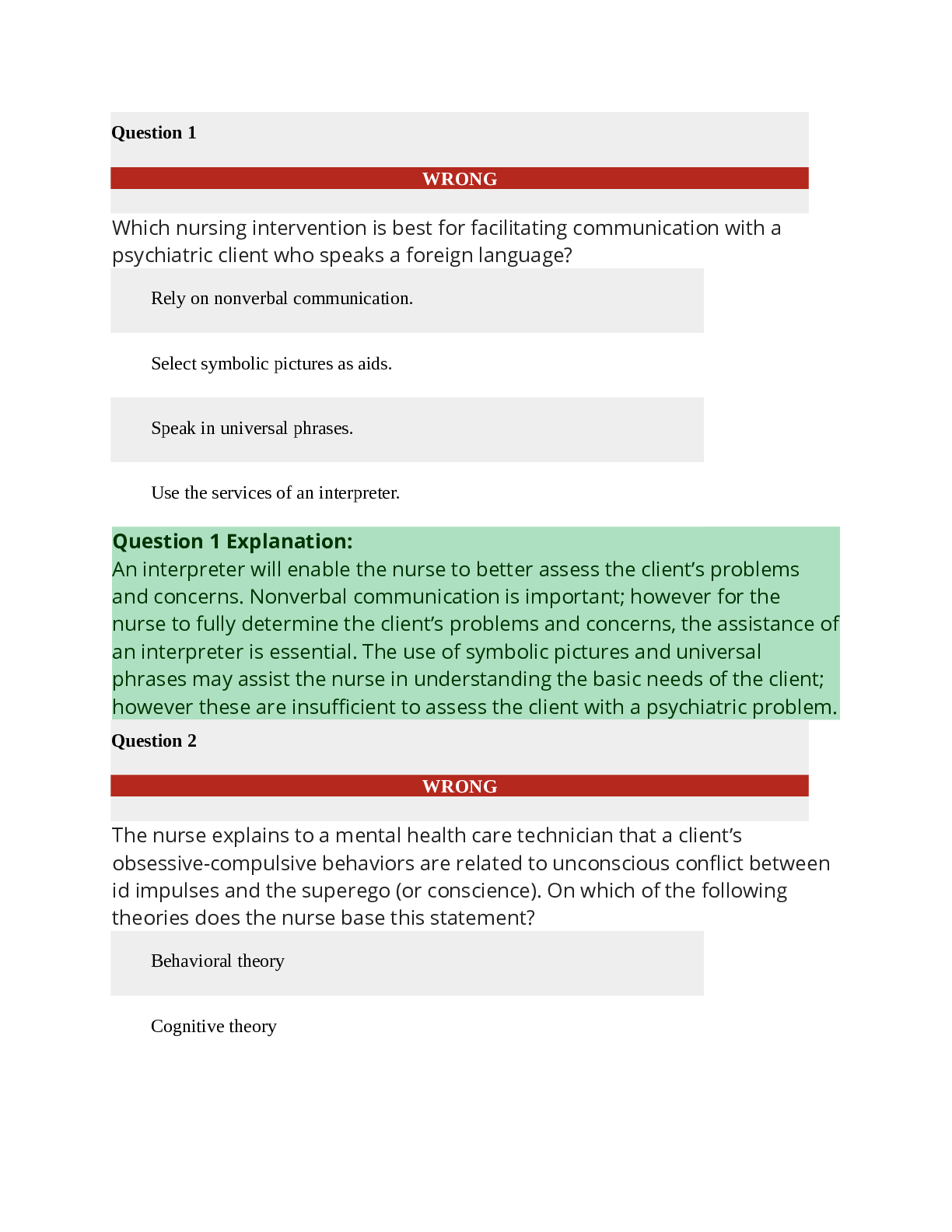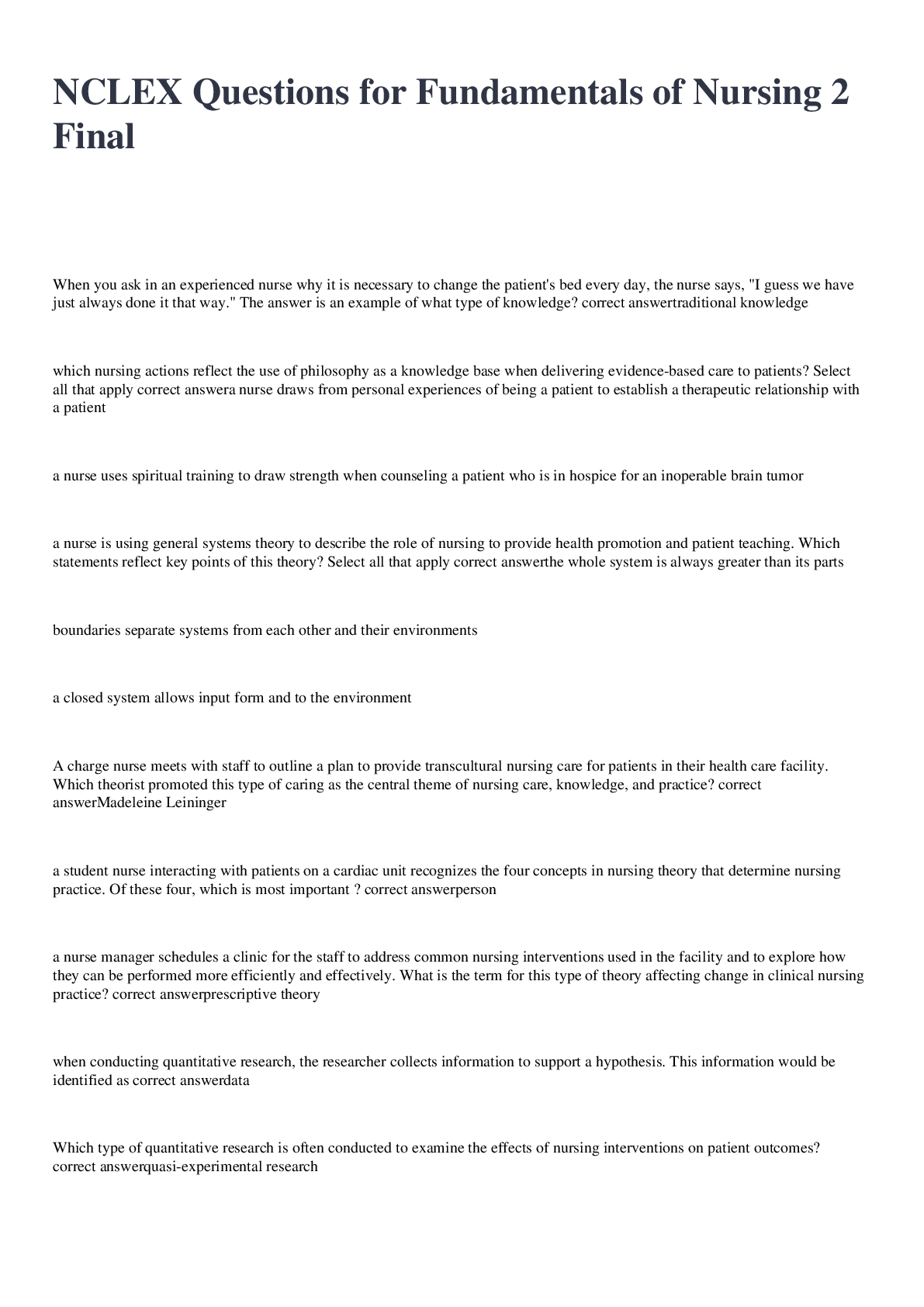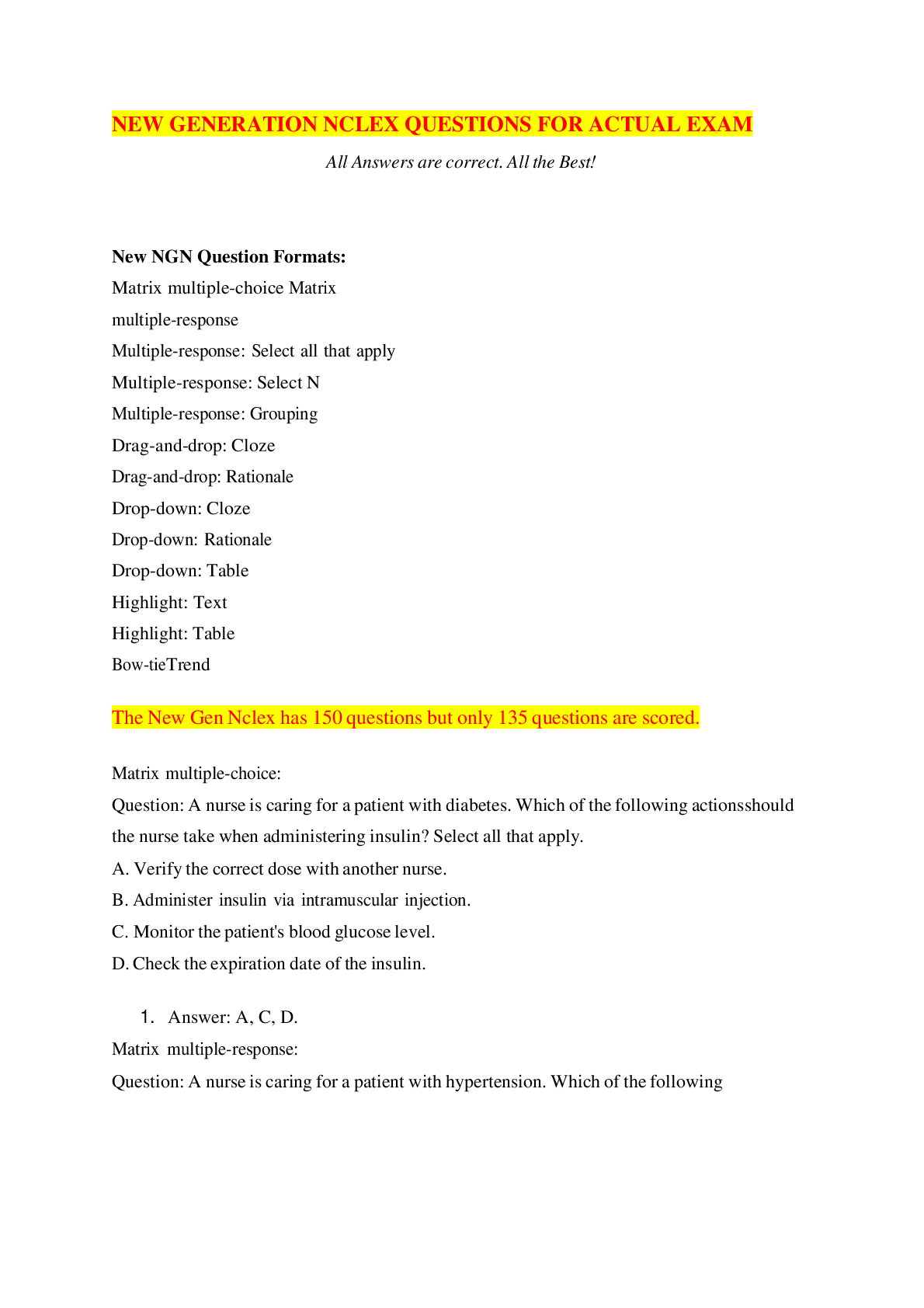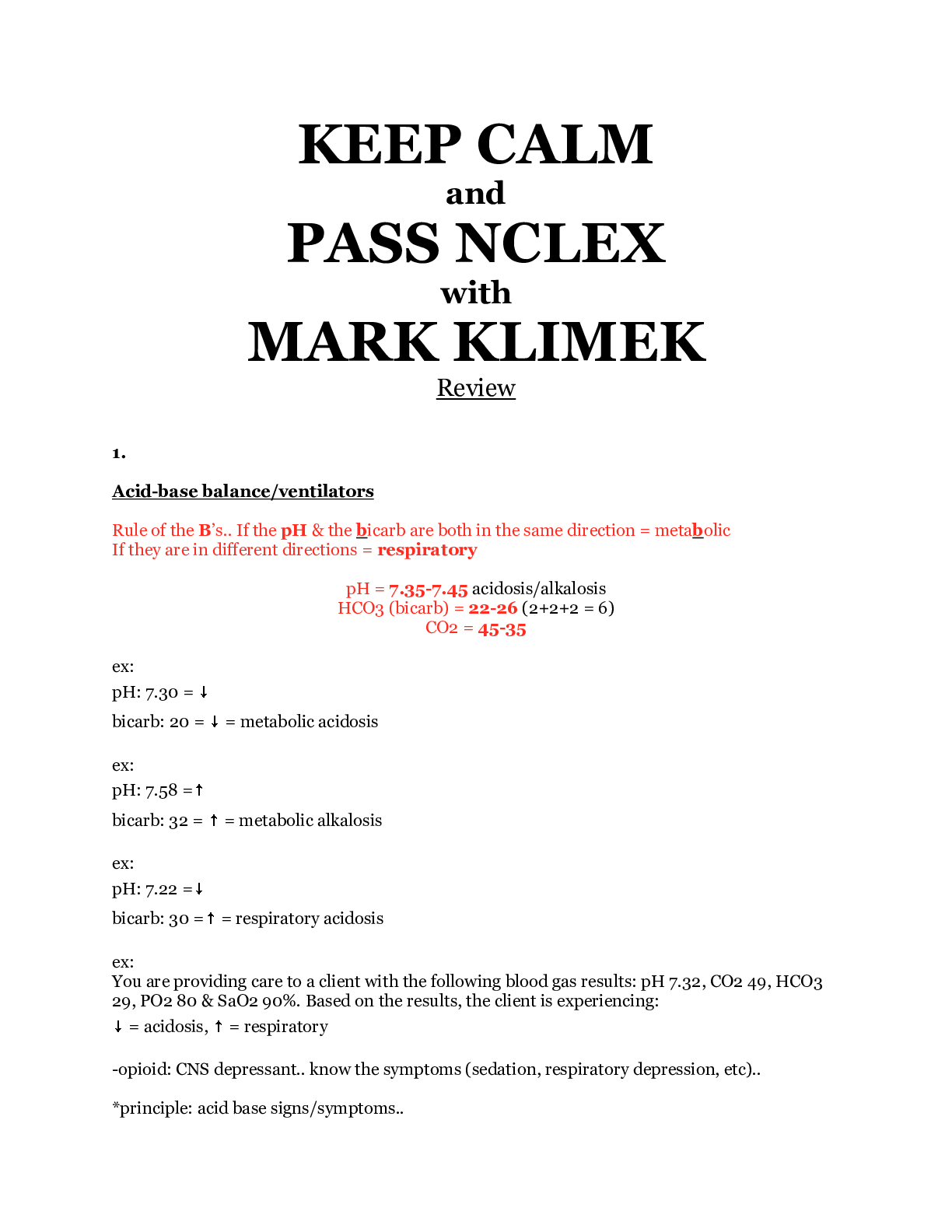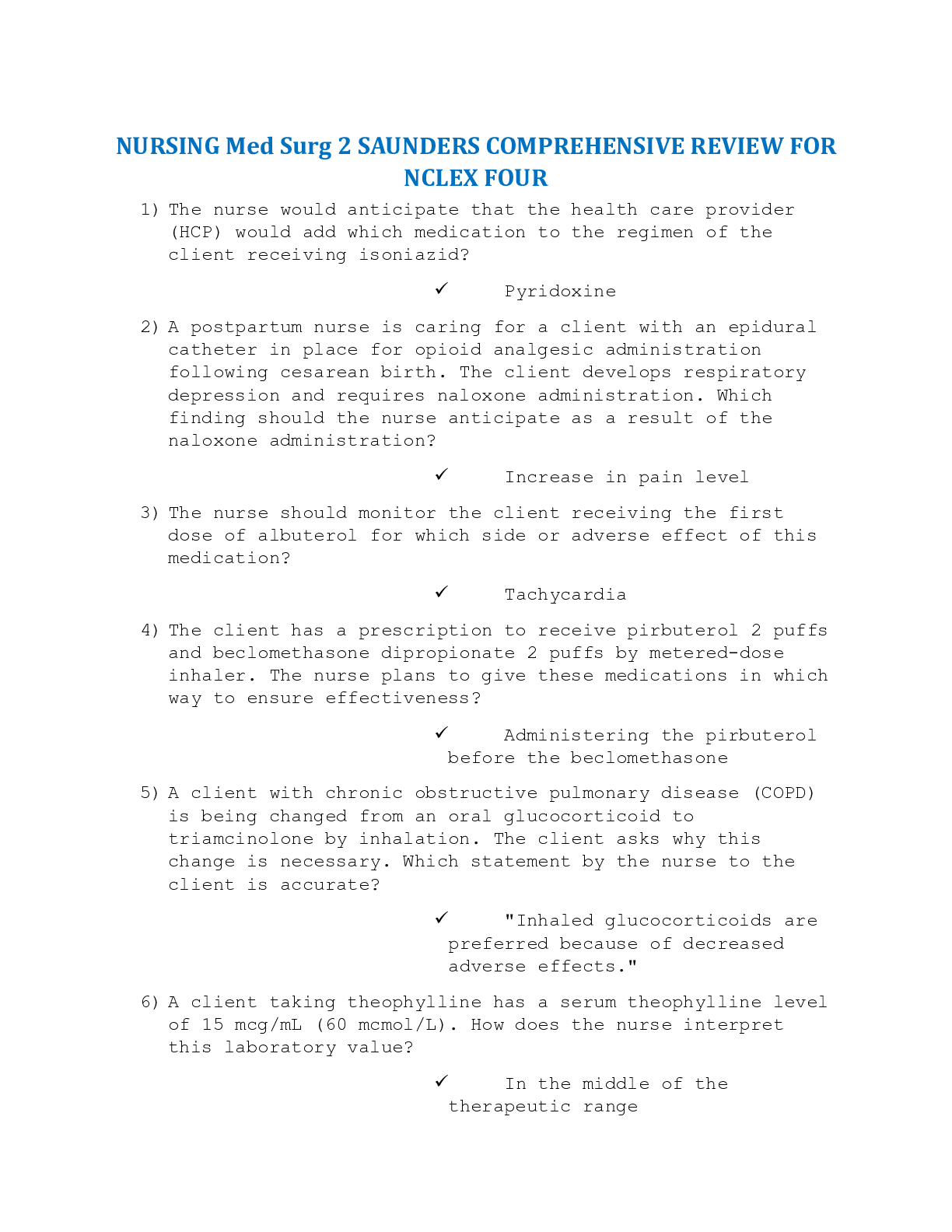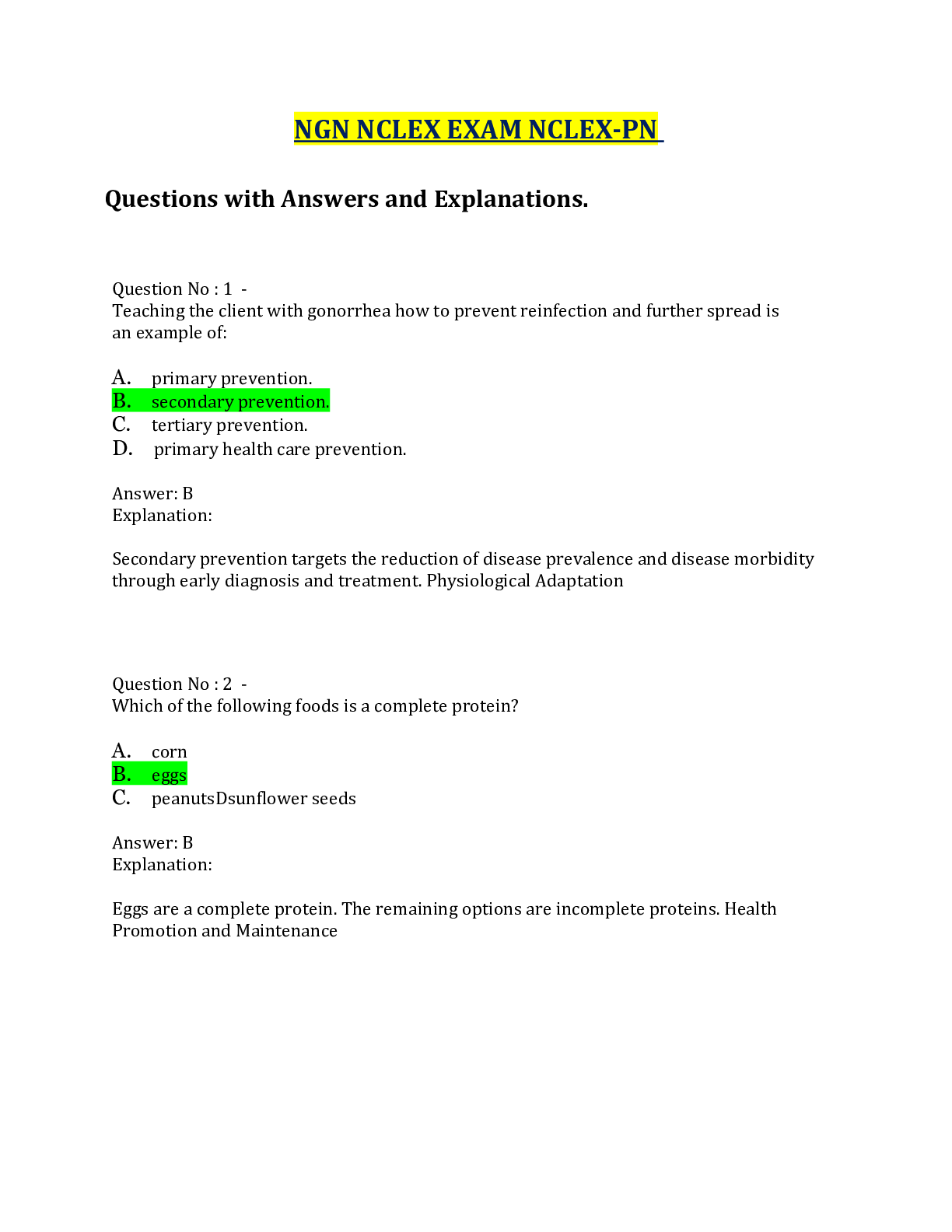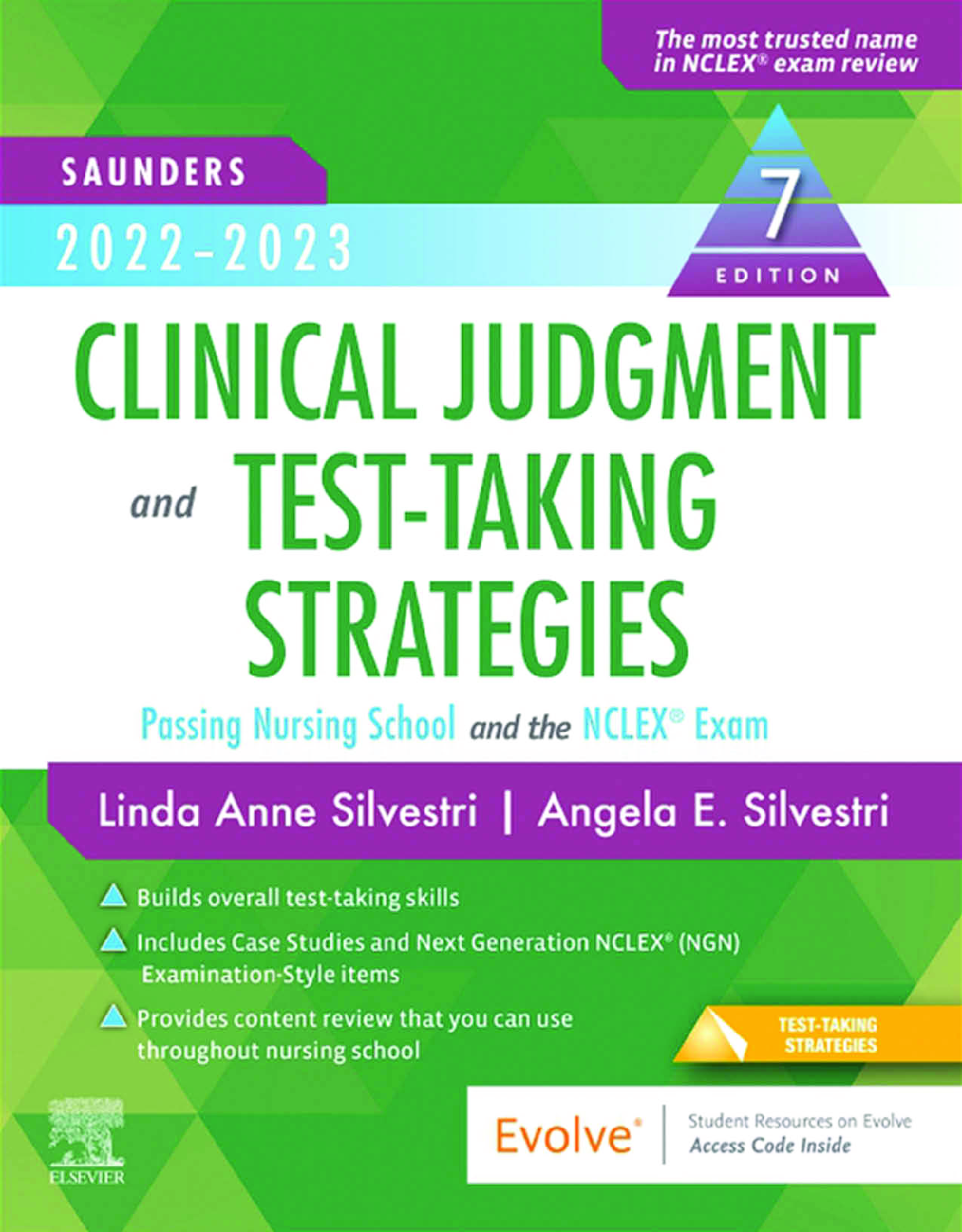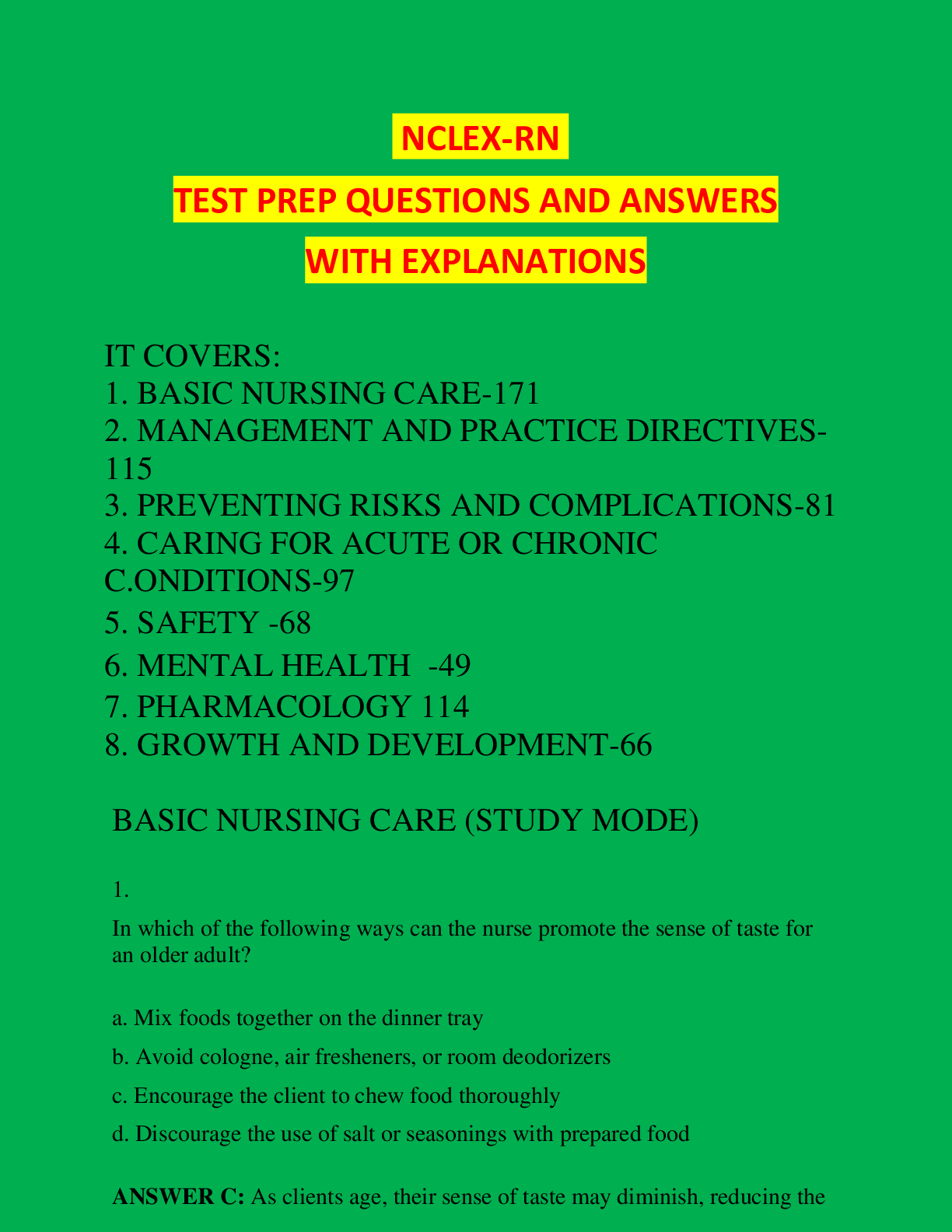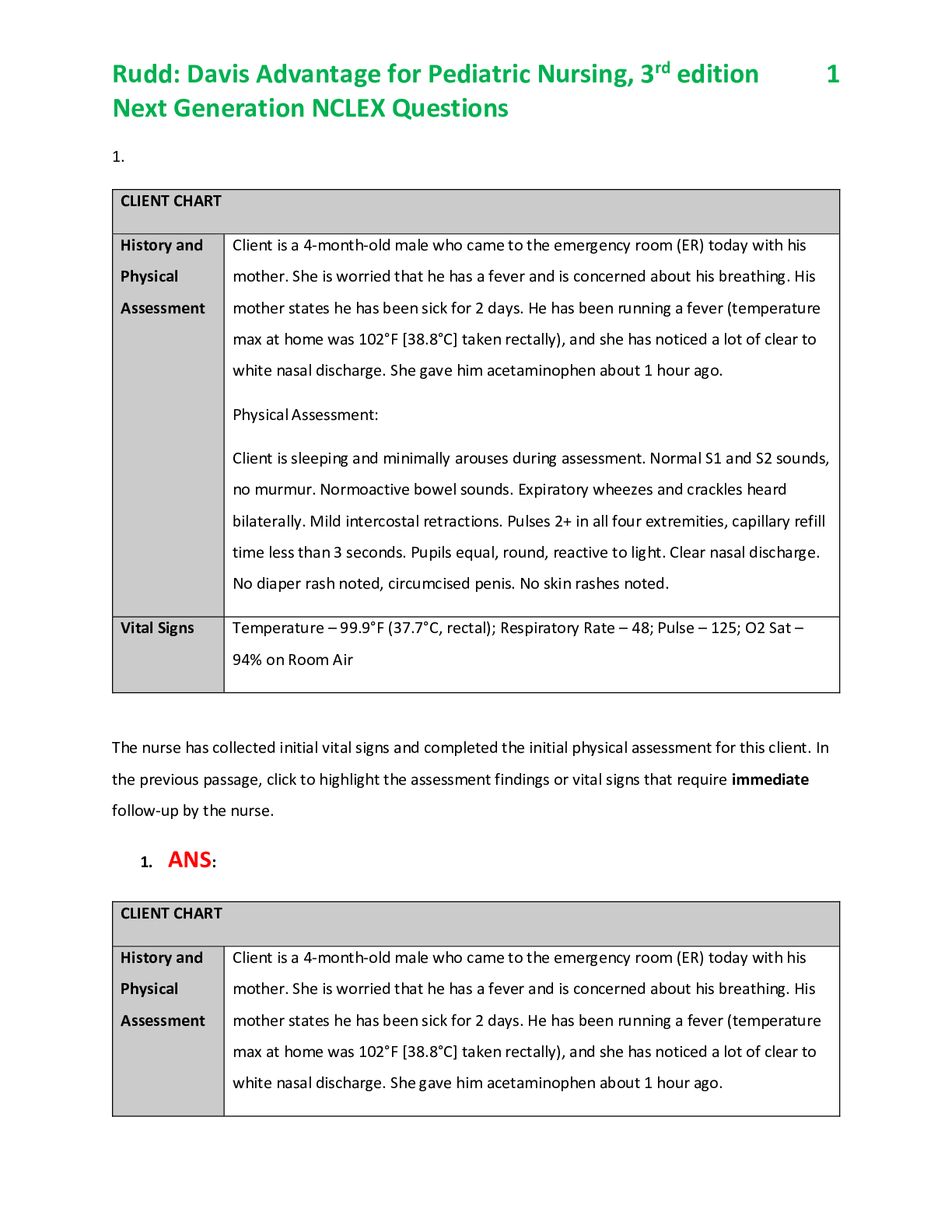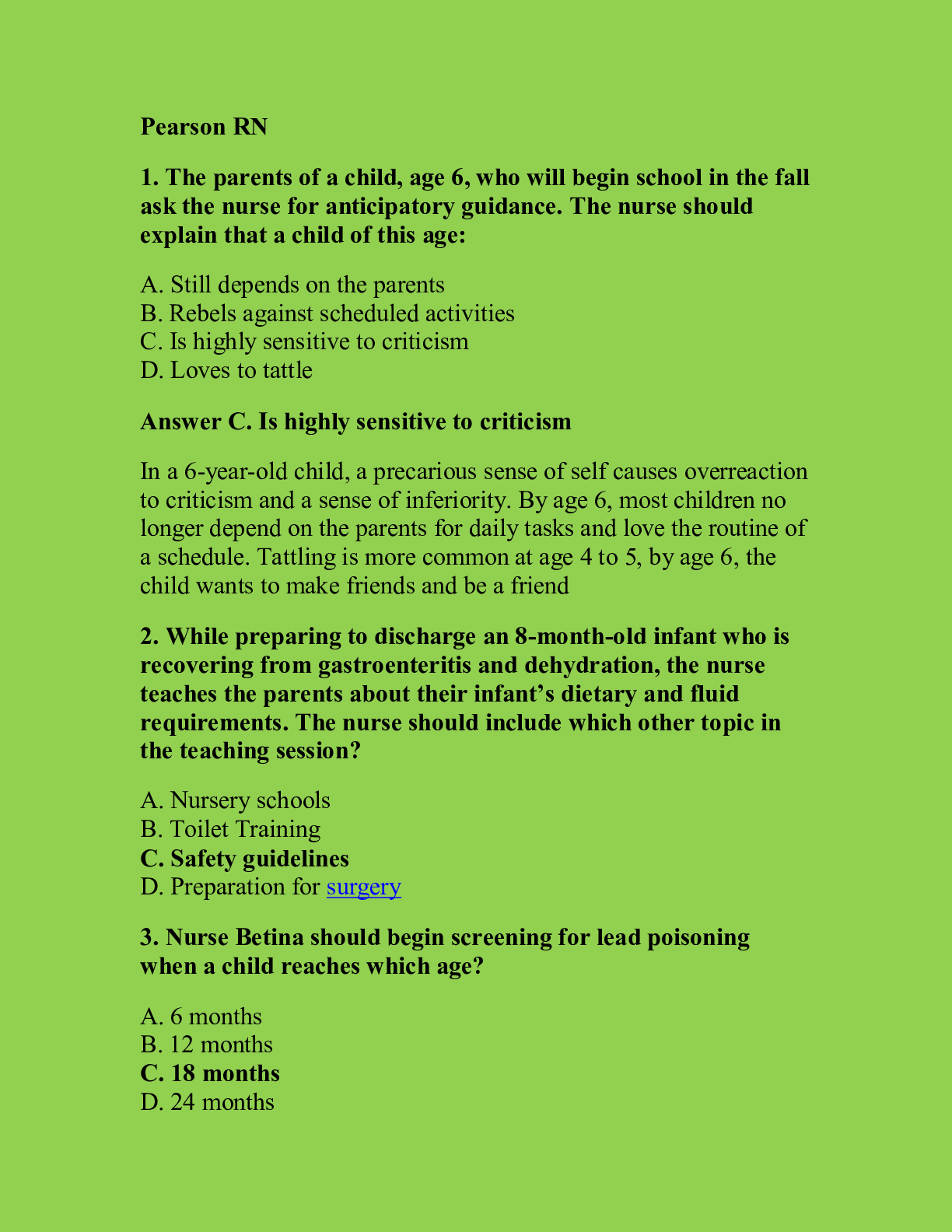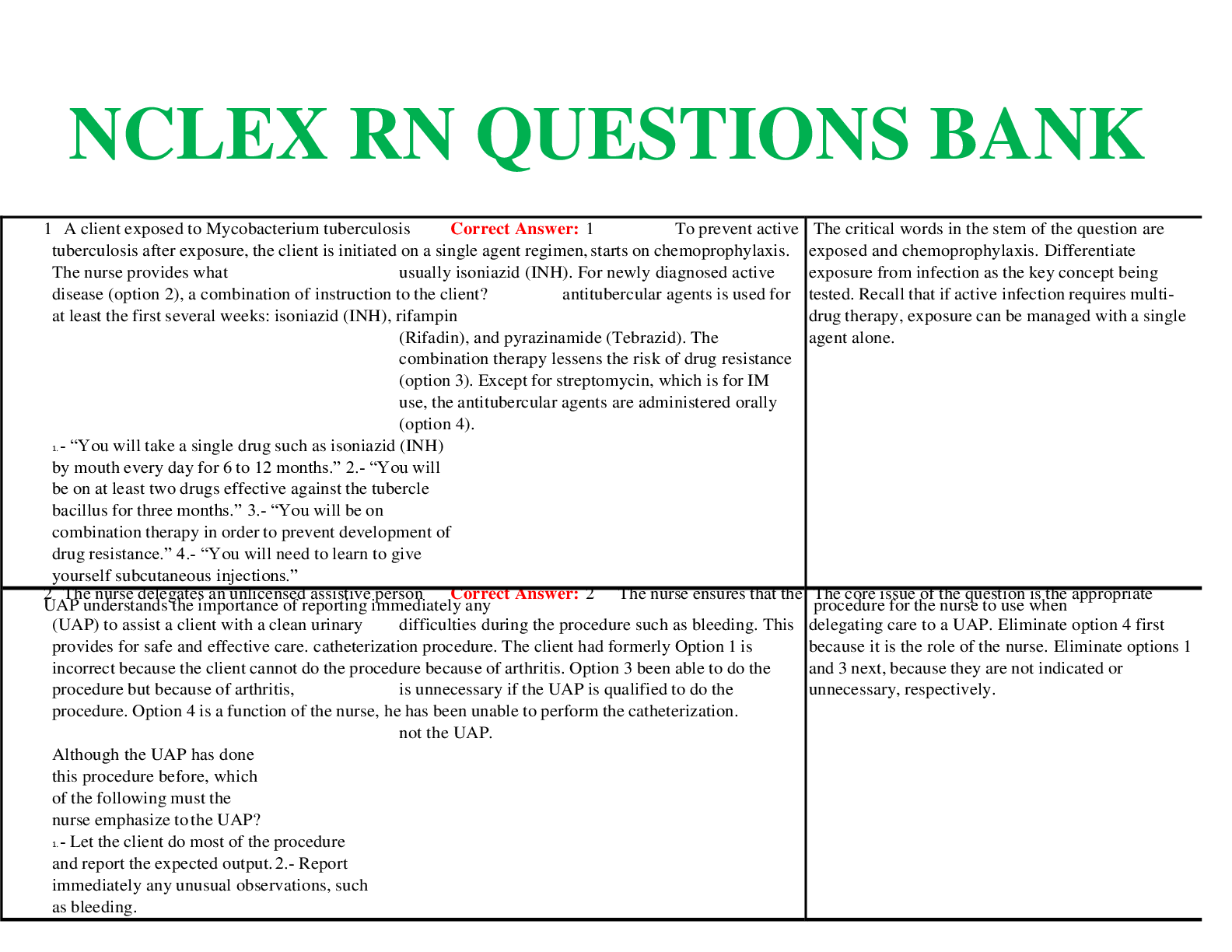*NURSING > NCLEX > Module 4- NCLEX QUESTIONS FOR BURNS with all the correct answers(A level work updated 2021) (All)
Module 4- NCLEX QUESTIONS FOR BURNS with all the correct answers(A level work updated 2021)
Document Content and Description Below
NCLEX QUESTIONS FOR BURNS Which of the following statements is correct about the nutritional needs of a burn client? a. The client needs 100 cal/kg throughout the hospitalization. b. The hypermet... abolic state after a burn injury leads to poor healing. c. Controlling the temperature og the environment decreases caloric demands. d. Maintaining a hypermetabolic rate decreases the client’s risk for infection. Which of the following statements is correct about the nutritional needs of a burn client? a. The client needs 100 cal/kg throughout the hospitalization. b. The hypermetabolic state after a burn injury leads to poor healing. c. Controlling the temperature og the environment decreases caloric demands. d. Maintaining a hypermetabolic rate decreases the client’s risk for infection. Which of the following characteristics is correct for a deep partial-thickness burn? a. Pain and redness b. Minimal damage to the epidermis c. Damaged tissue through all layers of skin d. Damaged tissue through most of the dermis Which of the following characteristics is correct for a deep partial-thickness burn? a. Pain and redness b. Minimal damage to the epidermis c. Damaged tissue through all layers of skin d. Damaged tissue through most of the dermis Which of the following surgical interventions is needed to correct difficulty breathing from a full-thickness circumferential burn to the chest? a. Intubation b. Eschartotomy c. Needle thoracentesis d. Insertion of a chest tube Which of the following surgical interventions is needed to correct difficulty breathing from a full-thickness circumferential burn to the chest? a. Intubation b. Eschartotomy c. Needle thoracentesis d. Insertion of a chest tube A client arrived at the emergency department after sustaining a major burn injury. Which of the following metabolic alteration is expected during the first 8 hours post-burn? a. Hyponatremia and hypokalemia b. Hyponatremia and hyperkalemia c. Hypernatremia and hypokalemia d. Hypernatremia and hyperkalemia A client has just arrived at the emergency department after sustaining a major burn injury. Which os the following metabolic alterations are expected during the first 8 hours post-burn? a. Hyponatremia and hypokalemia b. Hyponatremia and hyperkalemia c. Hypernatremia and hypokalemia d. Hypernatremia and hyperkalemia A client received burns to his entire back and circumferential left arm. Using the Rule of Nines, the nurse calculates that he has sustained burns to which of the following percentages of his body? a. 9% b. 18% c. 27% d. 36% A client received burns to his entire back and left arm. Using the Rule of Nines, the nurse calculates that he has sustained burns to which of the following percentages of his body? a. 9% b. 18% c. 27% d. 36% A client is newly admitted to the burn unit with extensive full-thickness burns. Which of the following considerations has priority? a. Fluid status b. Body image c. Level of pain d. Risk for infection A client is newly admitted to the burn unit with extensive full-thickness burns. Which of the following considerations has priority? a. Fluid status b. Body image c. Level of pain d. Risk for infection Which of the following characteristics is seen with deep partial-thickness burn wounds? a. Blanching b. Erythema c. Eschar d. Fluid-filled vesicles Which of the following characteristics is seen with deep partial-thickness burn wounds? a. Blanching b. Erythema c. Eschar d. Fluid-filled vesicles A client with extensive burns has a new donor site. Which of the following considerations is important in positioning the client? a. Make the site dependent b. Avoid pressure on the site c. Keep the site fully covered d. Allow ventilation of the site A client with extensive burns has a new donor site. Which of the following considerations is important in positioning the client? a. Make the site dependent b. Avoid pressure on the site c. Keep the site fully covered d. Allow ventilation of the site A client arrives at eh emergency department with chemical burns to both legs. Which of the following treatments has priority for this client? a. Dilute the burns b. Apply sterile dressings c. Apply topical antibiotics d. Debride and graft the burns A client arrives at eh emergency department with chemical burns to both legs. Which of the following treatments has priority for this client? a. Dilute the burns b. Apply sterile dressings c. Apply topical antibiotics d. Debride and graft the burns What is the first consideration for a patient that has an electrical burn? a. Determining an entrance and exit wound b. Determine a cardiac rhythm c. Determine any other injuries d. Determine amount/color of urinary output What are the first considerations for a patient that has an electrical burn? Select all that apply: a. Determining an entrance and exit wound b. Determine a cardiac rhythm c. Determine any other injuries d. Determine amount/color of urinary output Using the Parkland Formula: A client weighing 165lb. with 20% TBSA burns would require… • 1 st 24 hours Total Fluids _____ mL • 1 st 8 hours = _____ mL/hr • Remaining fluids = _____ mL/hr Using the Parkland Formula: A client weighing 165lb. with 20% TBSA burns would require… • 165 / 2.2 = 75kg • 75kg x 20% x 4mL = 6,000 mL of fluid replacement within 24 hours. • The first half of this amount is delivered within 8 hours from the burn incident, 3000 / 8 = 375mL/hr • The remaining fluid is delivered in the next 16 hours. 3000 / 16 = 187.5 (IVF are rounded to whole number) = 188 mL/hr Determine TBSA and Parkland formula for a client weighing 160 pounds, burned on their anterior torso and bilateral arms. • Total fluid amount _____mL • 1 st 8 hours _____ mL/hr • Remaining amount _____ mL/hr Determine BSA% and Parkland formula for a client weighing 160 pounds, burned on their anterior torso and bilateral anterior arms. • 160 / 2.2= 73kg; 18% + 4.5% + 4.5% = 27% TBSA • 27% x 73kg x 4mL = 7,884mL in 24 hours • 3,942ml/8hrs = 493mL/hr • 3,942ml/16hrs= 246mL/hr [Show More]
Last updated: 1 year ago
Preview 1 out of 25 pages
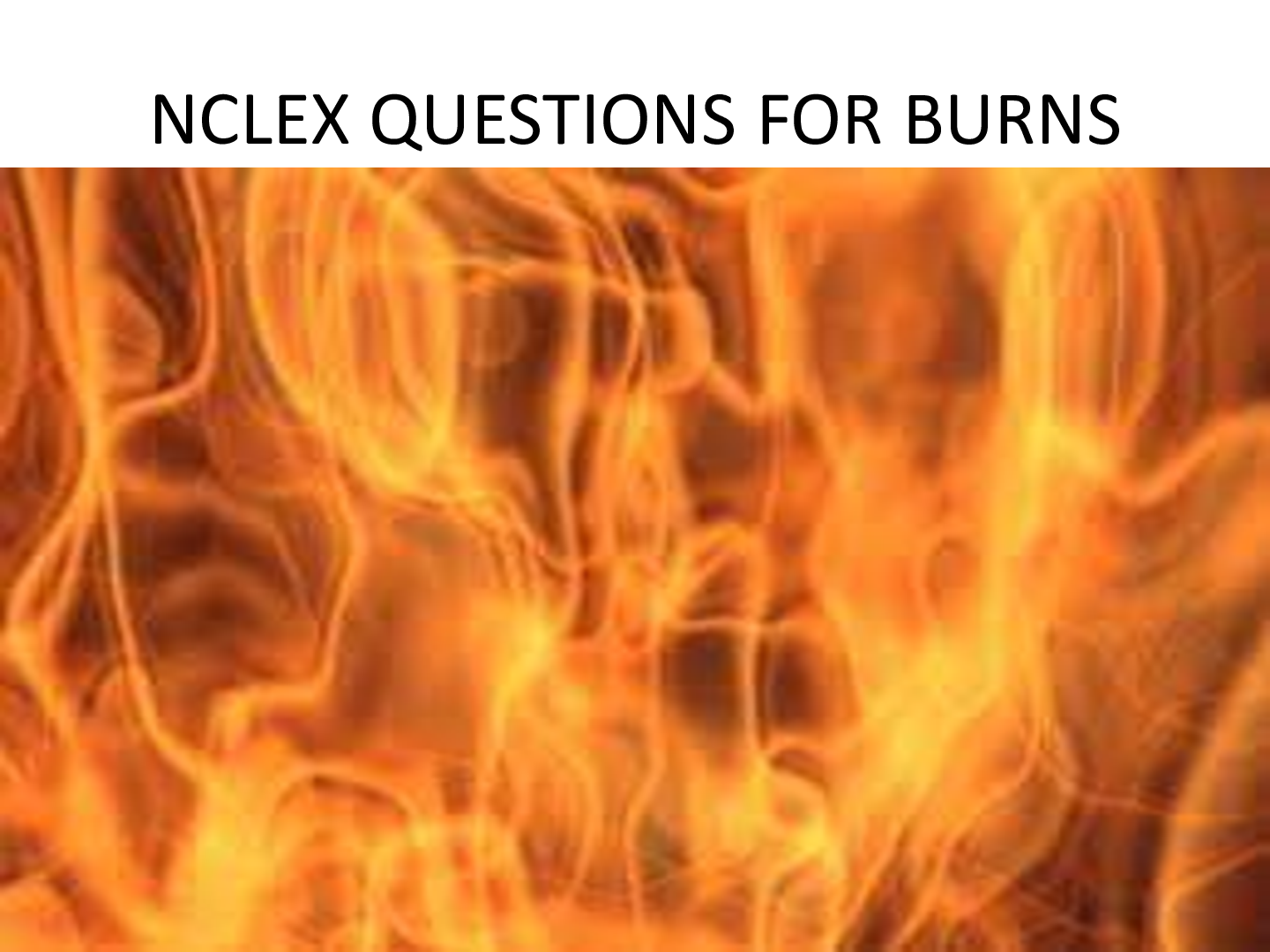
Reviews( 0 )
Document information
Connected school, study & course
About the document
Uploaded On
Jan 12, 2021
Number of pages
25
Written in
Additional information
This document has been written for:
Uploaded
Jan 12, 2021
Downloads
0
Views
70


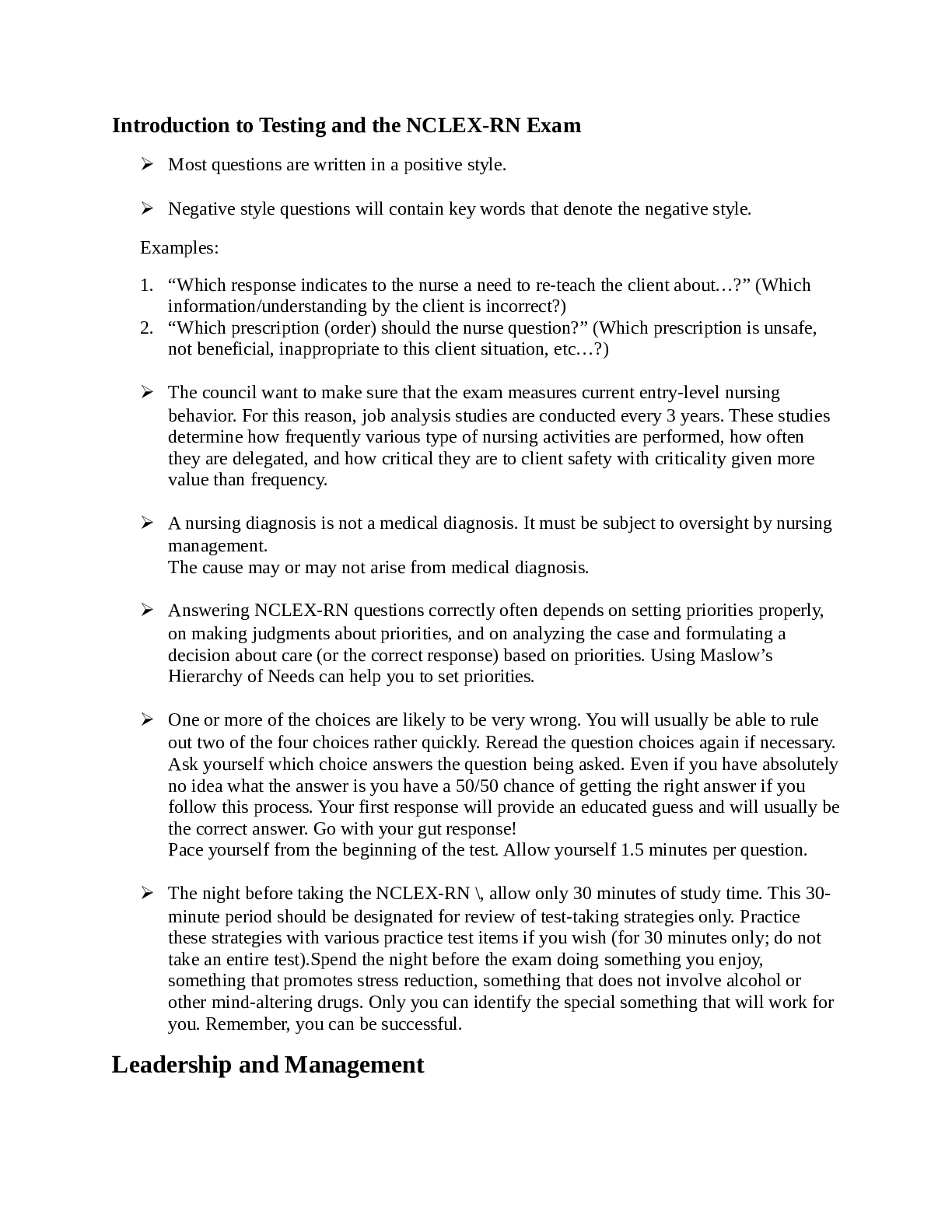
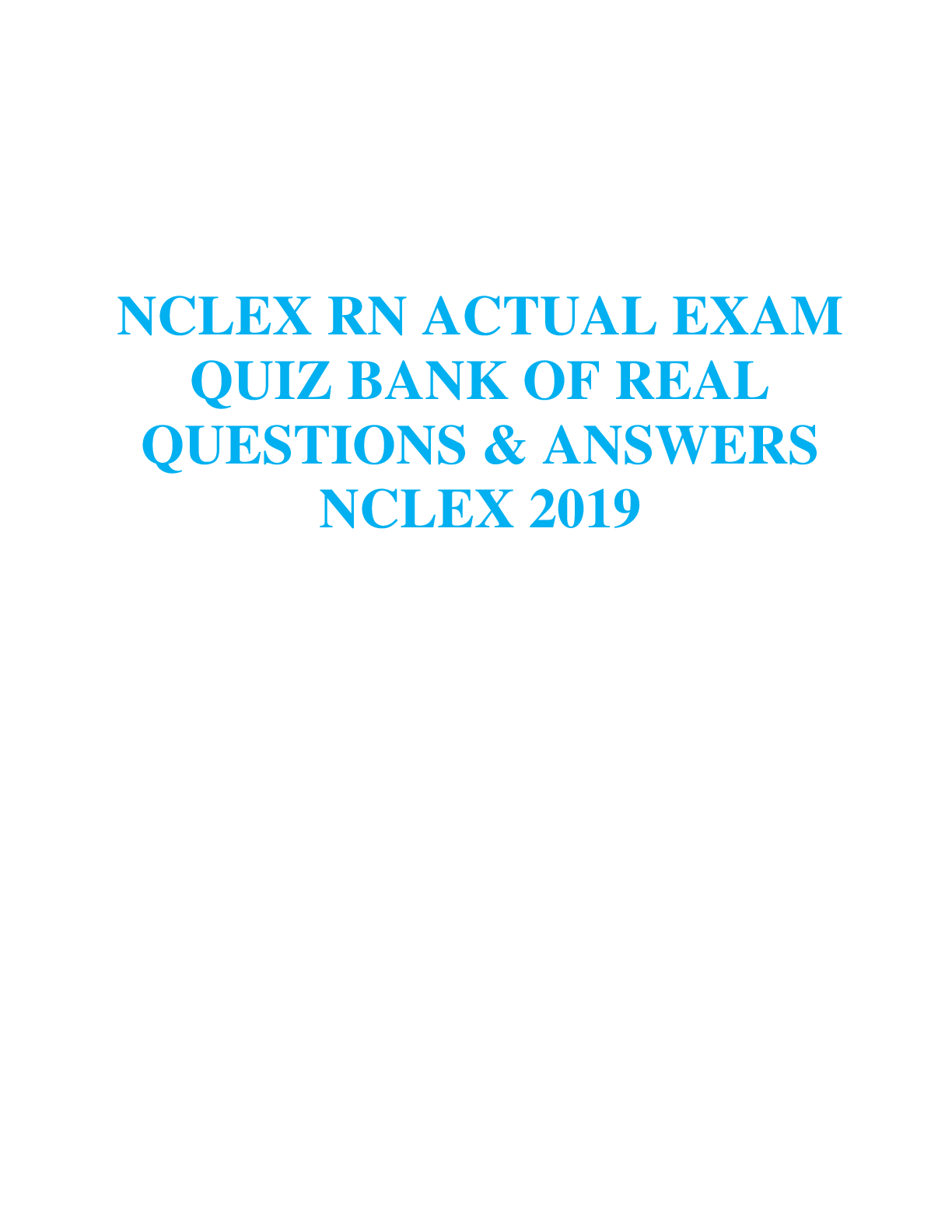
.png)

